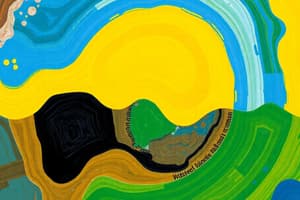Podcast
Questions and Answers
Who proposed the theory of Pangaea?
Who proposed the theory of Pangaea?
- Marie Curie
- Alfred Wegener (correct)
- Isaac Newton
- Charles Darwin
What was the supercontinent formed during the late Paleozoic era called?
What was the supercontinent formed during the late Paleozoic era called?
- Laurasia
- Gondwana
- Panthalassa
- Pangaea (correct)
What geological forces led to the formation of Pangaea?
What geological forces led to the formation of Pangaea?
- Meteor impacts
- Tectonic plate subduction
- Continental drift (correct)
- Volcanic eruptions
What caused the breaking up of Pangaea?
What caused the breaking up of Pangaea?
What did Alfred Wegener observe that led to his theory of continental drift?
What did Alfred Wegener observe that led to his theory of continental drift?
$Pangaea$ existed until approximately how many million years ago?
$Pangaea$ existed until approximately how many million years ago?
What was the name of the large C-shaped supercontinent surrounded by the Panthalassa ocean?
What was the name of the large C-shaped supercontinent surrounded by the Panthalassa ocean?
What was the name of the sea that formed between Laurasia and Gondwana?
What was the name of the sea that formed between Laurasia and Gondwana?
What was the process that led to the formation of Pangaea?
What was the process that led to the formation of Pangaea?
Who first proposed the map of Pangaea based on observations of complementary coastlines and fossil distribution?
Who first proposed the map of Pangaea based on observations of complementary coastlines and fossil distribution?
What allowed scientists to determine the past and future positions of continents based on plate movement?
What allowed scientists to determine the past and future positions of continents based on plate movement?
$Pangaea$ began to break apart approximately how many million years ago?
$Pangaea$ began to break apart approximately how many million years ago?
What evidence supported the existence of Pangaea?
What evidence supported the existence of Pangaea?
Before Wegener's work, what was the common explanation for the wide distribution of similar fossils on different continents?
Before Wegener's work, what was the common explanation for the wide distribution of similar fossils on different continents?
Approximately how much do continents move per year due to tectonic plate movement?
Approximately how much do continents move per year due to tectonic plate movement?
Flashcards are hidden until you start studying
Study Notes
- Laurasia: supercontinent comprised of North America and most of Europe.
- Gondwana: supercontinent composed of South America, Africa, Antarctica, Australia, and Indo-Pakistan.
- Tethys Sea: sea that formed between Laurasia and Gondwana.
- Pangaea: supercontinent formed of "all the Earth"; derived from Greek words "pan" (all) and "gaia" (earth).
- Pangaea's formation: result of continental drift, a process where tectonic plates collide and separate, floating on a fluid mantle of magma.
- Pangaea map: first proposed by Wegener based on the observation of South America and Africa's complementary coastlines and the distribution of fossils and geological features across oceans.
- Tectonic plate movement: continents move 2.5 cm a year, allowing scientists to determine the past and future positions based on plate movement.
- Supercontinent breakup: began approximately 200 million years ago, with the formation of the Tethys Sea.
- Gondwana: began to break apart 150 million years later, forming the Atlantic ocean between South America and Africa.
- Laurasia: broke into North America, Europe, and Asia approximately 66-30 million years ago.
- Tectonic plates: 15 largest tectonic plates of the Earth in constant motion, causing landforms and shaping continents.
- Evidence for Pangaea's existence: Wegener's observations of continents seemingly fitting together, fossil distribution, and rock strata patterns.
- Pre-Wegener theories: before Wegener's work, the common explanation for the wide distribution of similar fossils on different continents was the existence of land bridges.
Key facts and context about the formation and evidence of the supercontinent Pangaea.
Studying That Suits You
Use AI to generate personalized quizzes and flashcards to suit your learning preferences.




